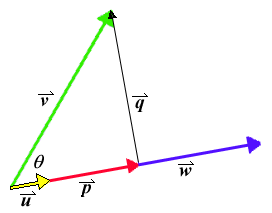Vectors in Two and Three Dimensions
Part 6: Projections
- Use the applet below to investigate
the projection of a vector v (green) onto another vector w
(yellow ) in space, which we will relate shortly to the dot product <v,w>.
You can adjust the components of the yellow and green vectors and then ask
the applet to compute the projection of the green vector onto the yellow.
The slider at the bottom allows you to rotate the view of the vectors. To
help keep you oriented, the projections of the green and yellow vectors onto
the xy-plane are also shown. The projection of a vector v onto
w is a vector in the same or opposite direction as w, so there
are two things to be determined: "same or opposite" and the length
of the projection. Think about how both of these might be related to the dot
product.
We will use the idea of projecting
one vector onto another to resolve a vector v into its components
parallel and perpendicular to a vector w. The idea is illustrated in
the following figure, which is drawn in the plane determined by v and
w.

In this figure, v is shown
in green and w in blue (partly obscured by u and p). The
vector p is the projection of v on w, and this is also
the component of v parallel to w. The component
of v perpendicular to w is q, and clearly v = p + q.
Thus, if we can find p from v and w, then we can calculate
q as q = v - p.
- For purposes of indicating the
direction of w, we first calculate a unit vector u (i.e., u
has length 1) in the same direction as u. How is u calculated
from w? Explain why p = |p| u. How is |p|
related to the length of v and the cosine of the angle
 between
them?
between
them?
- Observe that cos
 can
be calculated by taking the dot product of v with either of the vectors
w or u. (We can't use p for this purpose because we don't
know what it is yet -- that 's what we're trying to find.) Now put all the
pieces together to arrive at a formula for p by finding u, cos
can
be calculated by taking the dot product of v with either of the vectors
w or u. (We can't use p for this purpose because we don't
know what it is yet -- that 's what we're trying to find.) Now put all the
pieces together to arrive at a formula for p by finding u, cos
 , |p|, and finally p
itself.
, |p|, and finally p
itself.
- Carry out your formula to find
the projection of v = (2,1,3) onto w = (2,4,2).
Then find both the parallel and perpendicular components of v relative
to w. If your calculation is correct, the two components should be
perpendicular -- check that.
- Use your formula for p
to show that p and v - p are always perpendicular.
| CCP
Home | Materials | Multivariable
Calculus | Module Contents | Back
| Forward |
